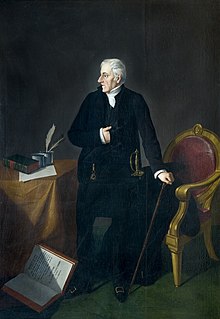Miguel Domínguez
Miguel Ramón Sebastián Domínguez Alemán (born January 20, 1756 in Mexico City , Mexico ; † April 22, 1830 ibid) was a Mexican civil servant who participated in the beginning of the Mexican War of Independence and in 1823 after the overthrow of the Emperor Agustín de Iturbide, the Supreme Governmental Body Belonged to Mexico.
Life
Miguel Domínguez was born in Mexico City to a Spanish family. His father, Miguel Domínguez Ginuesio, was a doctor, his mother's name was Josefa Alemán Trujillo.
Miguel studied law in Mexico at the Colegio de San Ildefonso and graduated from the bar at the age of 19. At the age of 29 he was a member of the bar association.
In 1791 he met Josefa Ortiz while teaching at the girls' school Colegio de las Vizcaínas ; the two fell in love and got married that same year.
Miguel Domínguez took over several offices in the Spanish colonial administration and worked in the financial administration until Viceroy Félix Berenguer de Marquina appointed him corregidor (provincial governor) of Querétaro in 1802 . He fought against the exploitation and mistreatment of the indigenous population by the large landowners.
When the Spanish King Ferdinand VII was arrested by Napoleon Bonaparte in 1808 in order to elevate Napoleon's brother Joseph Bonaparte to the Spanish throne, Domínguez demanded a Mexican government independent of Spain. This was a radical position, most Mexicans sought a more or less stable interim solution that would remain loyal to King Ferdinand and keep Mexico out of the turmoil of the Napoleonic Wars .
In the city of Querétaro , under the guise of a literary society, a group of conspirators formed who, under the leadership of Domínguez's wife, Josefa Ortiz de Domínguez , forged plans for a coup. Juan Aldama , Ignacio Allende , Miguel Hidalgo and, a little later, Mariano Abasolo came to the secret meetings . The conspirators planned to start the armed uprising on October 1, 1810. To what extent Domínguez was privy to the plans of the conspirators and approved them is not known.
On September 10, 1810, the conspiracy was betrayed. Domínguez received an order from the viceroy to arrest all the conspirators. He had a suspect's home searched in Querétaro, found weapons and arrested some suspects. His wife, whom he left in his own house under the guard of the servants, was able to send a messenger to Dolores to Miguel Hidalgo, who reacted promptly and on September 16, 1810, with the Grito de Dolores , gathered the population behind him and the revolt began became the Mexican War of Independence .
After the first wave of the uprising fizzled out and the Spaniards regained control of Mexico, Domínguez and his wife were captured in 1813. While Domínguez was soon released, his wife Josefa Ortiz was brought to Mexico City to the monastery of St. Theresa. Domínguez then also moved to the capital to visit his wife and take on her defense as a lawyer.
After King Ferdinand's return, he made a petition for clemency to the viceroy Juan Ruiz de Apodaca . She was released in June 1817 and Domínguez received a pension.
He stepped into the public eye again when the Mexican Emperor Agustín resigned in March 1823 to implement the plan of Casa Mata by Generals Antonio López de Santa Anna and Guadalupe Victoria . Until the federal republic was constituted and the constitution could be passed in October, a triumvirate ruled the country, which also included Miguel Domínguez.
In 1824 he was appointed Chairman of the Supreme Court of the United Mexican States; he held this office until his death in 1830.
literature
- Isidro Vizcaya Canales: En los albores de la Independencia: las Provincias Internas durante la insurrección de don Miguel Hidalgo y Costilla, 1810-1811 . Fondo Editorial Nuevo León, Monterrey, Mexico 2005, ISBN 970-9715-04-6 ( limited preview in Google Book Search [accessed February 3, 2016]).
- Alejandro Villaseñor y Villaseñor: Biographies de los heroes y caudillos de la Independencia . Imprenta de "El Tiempo" de Victoriano Agüeros, Mexico City, Mexico 1910 ( UNAM Online [accessed February 14, 2016]).
Web links
- Biography (spanish)
Individual evidence
- ↑ Miguel Domínguez. June 28, 2010, accessed February 26, 2020 (Spanish).
| personal data | |
|---|---|
| SURNAME | Domínguez, Miguel |
| ALTERNATIVE NAMES | Domínguez Alemán, Miguel Ramón Sebastián (full name) |
| BRIEF DESCRIPTION | Mexican politician |
| DATE OF BIRTH | January 20, 1756 |
| PLACE OF BIRTH | Mexico city |
| DATE OF DEATH | April 22, 1830 |
| Place of death | Mexico city |
